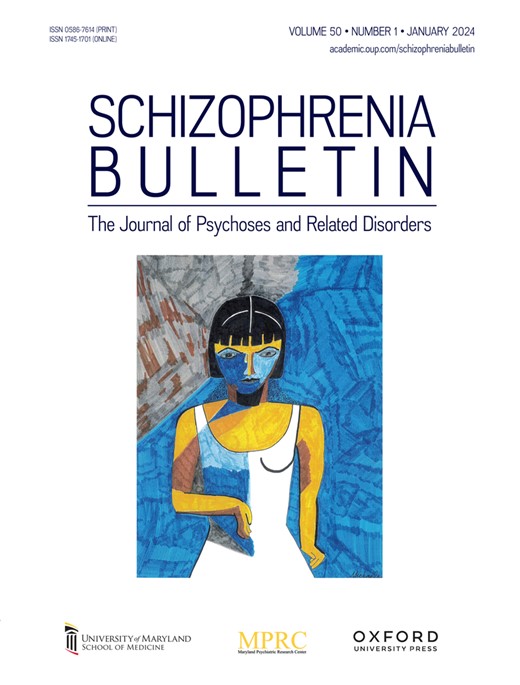Delineating the Transmission of Subthreshold Psychosis Symptoms Across Generations: The Philadelphia Family Neurodevelopmental Cohort
IF 5.3
1区 医学
Q1 PSYCHIATRY
引用次数: 0
Abstract
Background and Hypothesis Intergenerational factors are implicated in development of schizophrenia spectrum disorders. Studying psychosis spectrum (PS) symptoms dimensionally in a longitudinal, prospective intergenerational cohort can provide crucial insight into risk pathways. Thus, we established the Philadelphia Family Neurodevelopmental Cohort (PFNC), an intergenerational study that follows Philadelphia Neurodevelopmental Cohort (PNC) participants as they transition to parenthood, along with their offspring. This first report describes the creation of the PFNC, followed by an examination of longitudinal associations between risk factors assessed in adolescence (PS symptoms, cognition, and traumatic life events) and mental health and resilience outcomes in parenthood. Study Design Since the PNC was accrued (2009-2011; ages 8-21 years), many participants have become parents. As an initial step in the development of PFNC, participants completed a virtual self-report battery to assess parental status, family structure, current mental health symptoms, and parent-relevant risk and resilience factors. Study Results The current PFNC includes 456 PNC participants with 740 offspring, consisting primarily of biological mothers (female = 84%; Black = 65%; mean parent age = 28.38 years, SD = 3.40; mean offspring age = 4.01 years, SD = 3.36). Findings revealed adolescent PS symptoms and traumatic events are associated with PS symptoms in parenthood. Adolescent PS symptoms were also linked to higher levels of household chaos approximately 12 years later. Conclusion Despite the growing recognition of the intergenerational transmission of neuropsychiatric risk, there is limited research examining intergenerational risk factors in the context of PS symptoms. The PFNC represents a critical next step toward advancing our understanding of intergenerational pathways contributing to PS risk.描述阈下精神病症状的代际传递:费城家族神经发育队列
背景与假设代际因素与精神分裂症谱系障碍的发展有关。在纵向、前瞻性代际队列中,从维度上研究精神病谱系(PS)症状可以为风险途径提供重要的见解。因此,我们建立了费城家庭神经发育队列(PFNC),这是一项代际研究,跟踪费城神经发育队列(PNC)参与者以及他们的后代过渡为父母。这第一份报告描述了PFNC的创建,随后检查了青春期评估的风险因素(PS症状、认知和创伤性生活事件)与为人父母的心理健康和复原力结果之间的纵向关联。自PNC累积以来的研究设计(2009-2011;年龄在8-21岁之间),许多参与者已经为人父母。作为开发PFNC的第一步,参与者完成了一份虚拟自我报告,以评估父母状况、家庭结构、当前心理健康症状以及与父母相关的风险和恢复力因素。目前的PFNC包括456名PNC参与者和740名后代,主要由生母组成(女性= 84%;黑色= 65%;父母平均年龄28.38岁,SD = 3.40;平均子代年龄= 4.01岁,SD = 3.36)。研究结果显示,青少年的PS症状和创伤性事件与父母的PS症状有关。青春期的PS症状也与大约12年后更高程度的家庭混乱有关。结论:尽管越来越多的人认识到神经精神风险的代际传递,但在PS症状的背景下,对代际风险因素的研究有限。PFNC是推动我们理解代际途径导致PS风险的关键一步。
本文章由计算机程序翻译,如有差异,请以英文原文为准。
求助全文
约1分钟内获得全文
求助全文
来源期刊

Schizophrenia Bulletin
医学-精神病学
CiteScore
11.40
自引率
6.10%
发文量
163
审稿时长
4-8 weeks
期刊介绍:
Schizophrenia Bulletin seeks to review recent developments and empirically based hypotheses regarding the etiology and treatment of schizophrenia. We view the field as broad and deep, and will publish new knowledge ranging from the molecular basis to social and cultural factors. We will give new emphasis to translational reports which simultaneously highlight basic neurobiological mechanisms and clinical manifestations. Some of the Bulletin content is invited as special features or manuscripts organized as a theme by special guest editors. Most pages of the Bulletin are devoted to unsolicited manuscripts of high quality that report original data or where we can provide a special venue for a major study or workshop report. Supplement issues are sometimes provided for manuscripts reporting from a recent conference.
 求助内容:
求助内容: 应助结果提醒方式:
应助结果提醒方式:


